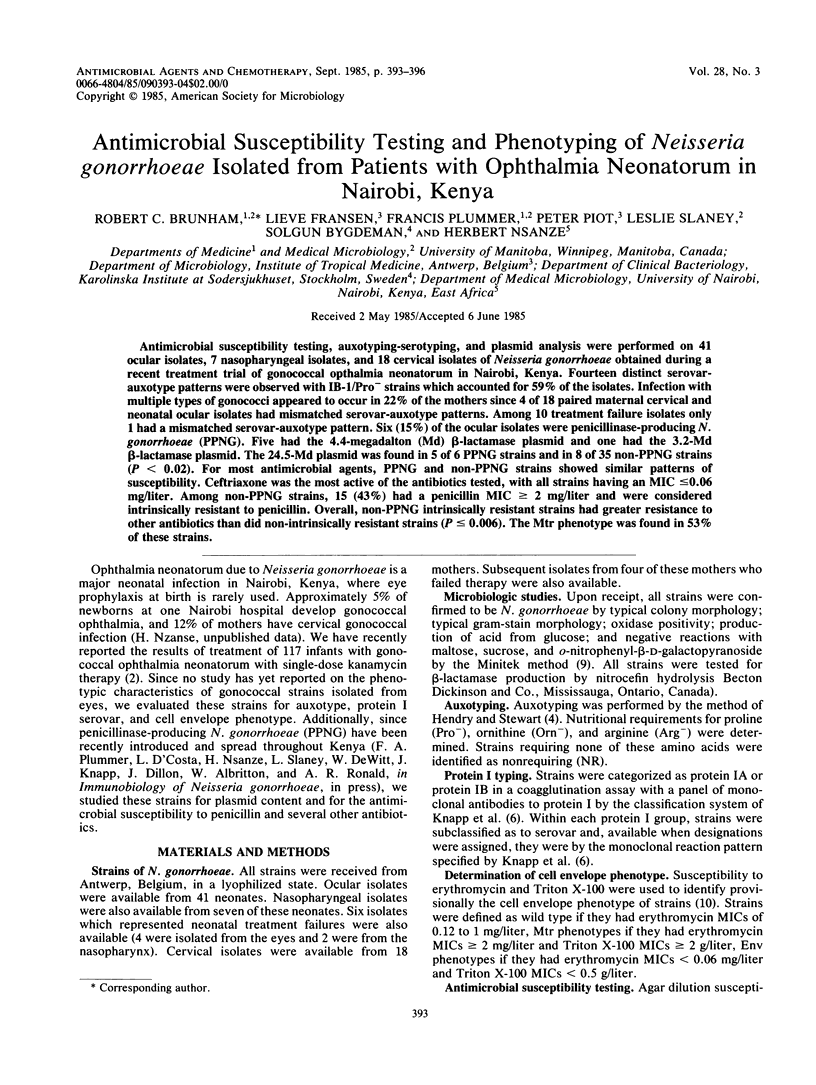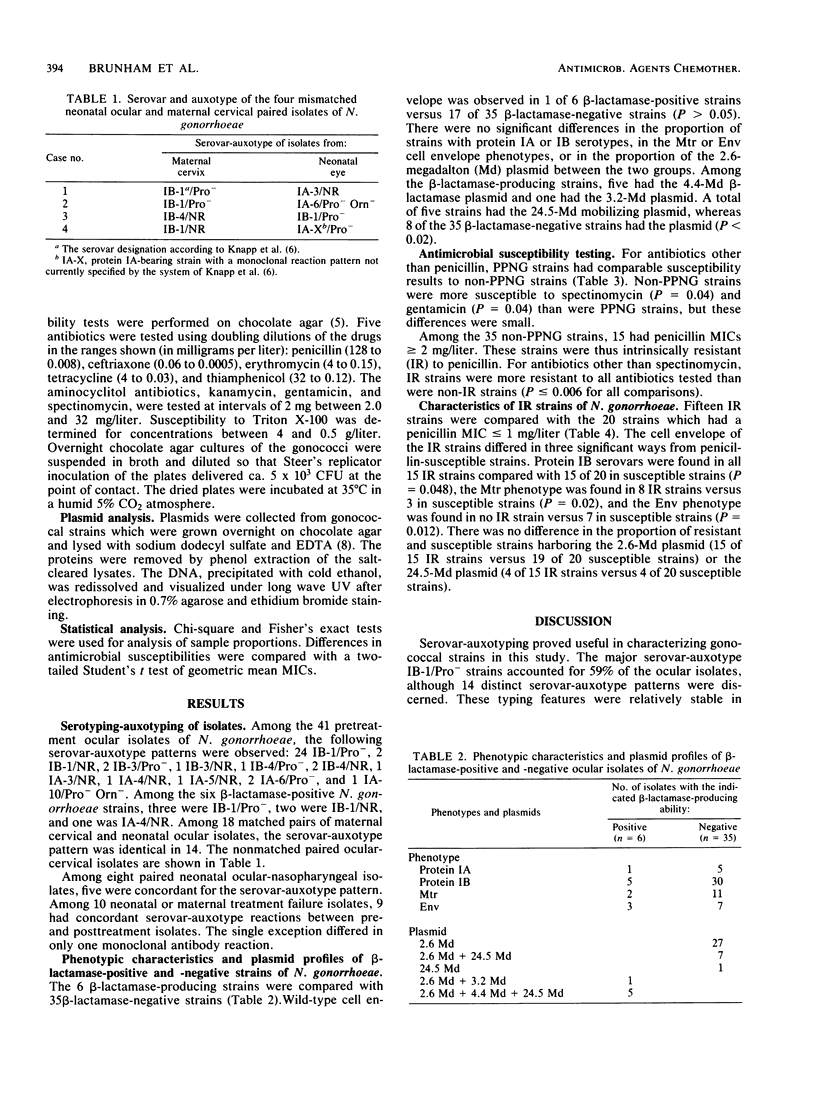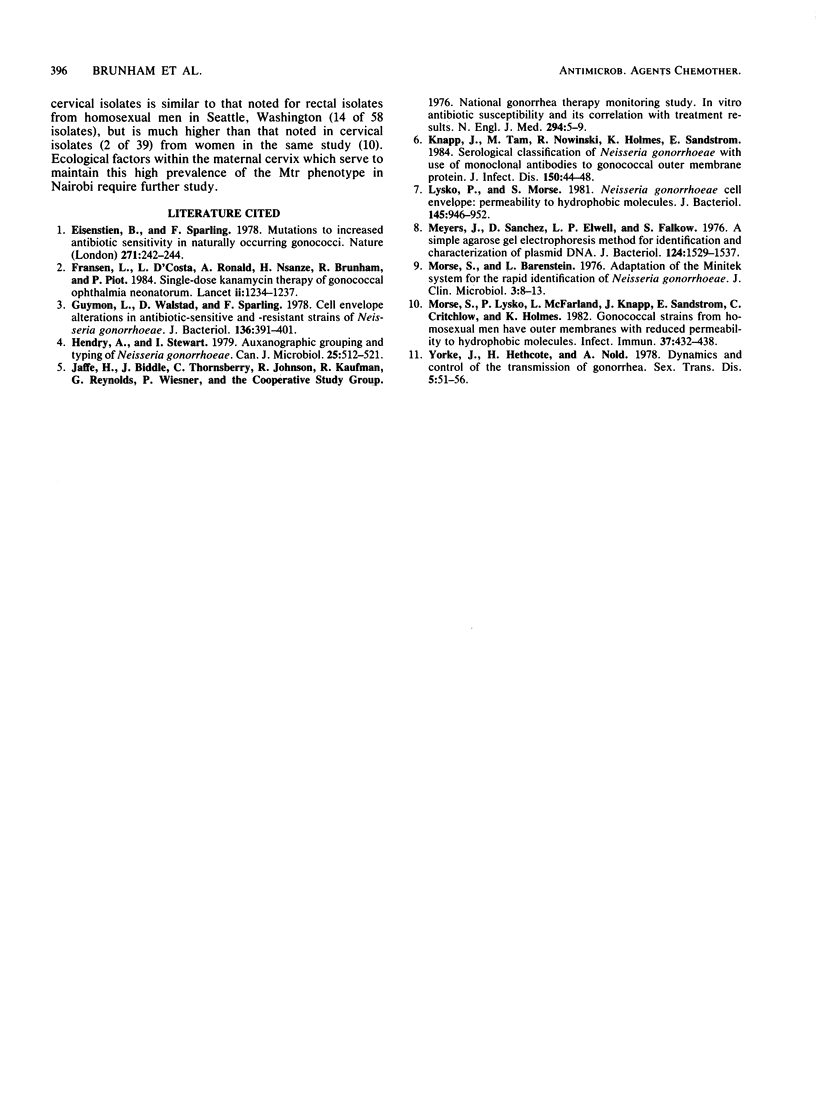Abstract
Antimicrobial susceptibility testing, auxotyping-serotyping, and plasmid analysis were performed on 41 ocular isolates, 7 nasopharyngeal isolates, and 18 cervical isolates of Neisseria gonorrhoeae obtained during a recent treatment trial of gonococcal ophthalmia neonatorum in Nairobi, Kenya. Fourteen distinct serovar-auxotype patterns were observed with IB-1/Pro-strains which accounted for 59% of the isolates. Infection with multiple types of gonococci appeared to occur in 22% of the mothers since 4 of 18 paired maternal cervical and neonatal ocular isolates had mismatched serovar-auxotype patterns. Among 10 treatment failure isolates only 1 had a mismatched serovar-auxotype pattern. Six (15%) of the ocular isolates were penicillinase-producing N. gonorrhoeae (PPNG). Five had the 4.4-megadalton (Md) beta-lactamase plasmid and one had the 3.2-Md beta-lactamase plasmid. The 24.5-Md plasmid was found in 5 of 6 PPNG strains and in 8 of 35 non-PPNG strains (P less than 0.02). For most antimicrobial agents, PPNG and non-PPNG strains showed similar patterns of susceptibility. Ceftriaxone was the most active of the antibiotics tested, with all strains having an MIC less than or equal to 0.06 mg/liter. Among non-PPNG strains, 15 (43%) had a penicillin MIC greater than or equal to 2 mg/liter and were considered intrinsically resistant to penicillin. Overall, non-PPNG intrinsically resistant strains had greater resistance to other antibiotics than did non-intrinsically resistant strains (P less than or equal to 0.006). The Mtr phenotype was found in 53% of these strains.
Full text
PDF



Selected References
These references are in PubMed. This may not be the complete list of references from this article.
- Eisenstein B. I., Sparling P. F. Mutations to increased antibiotic sensitivity in naturally-occurring gonococci. Nature. 1978 Jan 19;271(5642):242–244. doi: 10.1038/271242a0. [DOI] [PubMed] [Google Scholar]
- Fransen L., Nsanze H., D'Costa L., Brunham R. C., Ronald A. R., Piot P. Single-dose kanamycin therapy of gonococcal ophthalmia neonatorum. Lancet. 1984 Dec 1;2(8414):1234–1237. doi: 10.1016/s0140-6736(84)92794-6. [DOI] [PubMed] [Google Scholar]
- Guymon L. F., Walstad D. L., Sparling P. F. Cell envelope alterations in antibiotic-sensitive and-resistant strains of Neisseria gonorrhoeae. J Bacteriol. 1978 Oct;136(1):391–401. doi: 10.1128/jb.136.1.391-401.1978. [DOI] [PMC free article] [PubMed] [Google Scholar]
- Hendry A. T., Stewart I. O. Auxanographic grouping and typing of Neisseria gonorrhoeae. Can J Microbiol. 1979 Apr;25(4):512–521. doi: 10.1139/m79-075. [DOI] [PubMed] [Google Scholar]
- Knapp J. S., Tam M. R., Nowinski R. C., Holmes K. K., Sandström E. G. Serological classification of Neisseria gonorrhoeae with use of monoclonal antibodies to gonococcal outer membrane protein I. J Infect Dis. 1984 Jul;150(1):44–48. doi: 10.1093/infdis/150.1.44. [DOI] [PubMed] [Google Scholar]
- Lysko P. G., Morse S. A. Neisseria gonorrhoeae cell envelope: permeability to hydrophobic molecules. J Bacteriol. 1981 Feb;145(2):946–952. doi: 10.1128/jb.145.2.946-952.1981. [DOI] [PMC free article] [PubMed] [Google Scholar]
- Meyers J. A., Sanchez D., Elwell L. P., Falkow S. Simple agarose gel electrophoretic method for the identification and characterization of plasmid deoxyribonucleic acid. J Bacteriol. 1976 Sep;127(3):1529–1537. doi: 10.1128/jb.127.3.1529-1537.1976. [DOI] [PMC free article] [PubMed] [Google Scholar]
- Morse S. A., Bartenstein L. Adaptation of the Minitek system for the rapid identification of Neisseria gonorrhoeae. J Clin Microbiol. 1976 Jan;3(1):8–13. doi: 10.1128/jcm.3.1.8-13.1976. [DOI] [PMC free article] [PubMed] [Google Scholar]
- Morse S. A., Lysko P. G., McFarland L., Knapp J. S., Sandstrom E., Critchlow C., Holmes K. K. Gonococcal strains from homosexual men have outer membranes with reduced permeability to hydrophobic molecules. Infect Immun. 1982 Aug;37(2):432–438. doi: 10.1128/iai.37.2.432-438.1982. [DOI] [PMC free article] [PubMed] [Google Scholar]
- Yorke J. A., Hethcote H. W., Nold A. Dynamics and control of the transmission of gonorrhea. Sex Transm Dis. 1978 Apr-Jun;5(2):51–56. doi: 10.1097/00007435-197804000-00003. [DOI] [PubMed] [Google Scholar]


